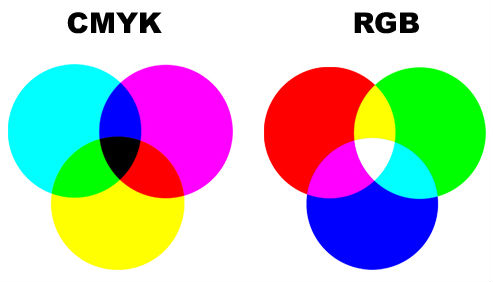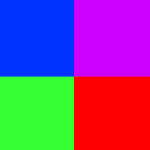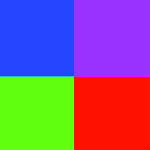CMYK to RGB
Would you like to convert the CMYK color to a RGB model ?
This is a free online color code converter, transform a color hue to another color model, supports three color models, CMYK, RGB and HEX, they can be converted to each other.
- CMYK to RGB and HEX
- RGB to CMYK and HEX
- HEX to RGB and CMYK
How to use this converter
- Input your color codes in any one color model area, CMYK, RGB or HEX
- To convert CMYK to RGB, input your CMYK color codes to CMYK area, for example, cmyk(100%, 0%, 33%, 40%)
- To convert CMYK to HEX, input codes to CMYK area
- To convert RGB to CMYK, input your RGB color codes to RGB area, for example, rgb(30, 100, 220)
- To convert RGB to HEX, input codes to RGB area
- To convert HEX to CMYK, input your HEX color codes to HEX area, for example, #3b5376
- To convert HEX to RGB, input codes to HEX area
- Our color code converter will show results interactively
How to convert CMYK to RGB
The Red, Green, Blue values are given in the range of 0..255, the red color(R) is calculated from the cyan(C) and black(K) colors, the green color(G) is calculated from the magenta(M) and black(K) colors, The blue color(B) is calculated from the yellow(Y) and black(K) colors. Below is the formula of CMYK to RGB convertion
- Red = 255 × ( 1 - Cyan ÷ 100 ) × ( 1 - Black ÷ 100 )
- Green = 255 × ( 1 - Magenta ÷ 100 ) × ( 1 - Black ÷ 100 )
- Blue = 255 × ( 1 - Yellow ÷ 100 ) × ( 1 - Black ÷ 100 )
How to convert RGB to CMYK
The max number of R, G, B values are 255, first of all, we divided them by 255 to become the number of 0~1, this ratio will be used in the calculation.- Rc = R ÷ 255
- Gc = G ÷ 255
- Bc = B ÷ 255
More free online color tools
- RGB to Pantone
- CMYK to Pantone (coated color)
- CMYK to Uncoated PMS (uncoated color)
- CMYK to RGB (CMYK, RGB, HEX color code converter)
- CMYK to HEX (CMYK, HEX, RGB color code converter)
- RGB to HSV (RGB, HSV, HSL, HEX color code converter)
- Find PMS color on an image (Logo color picker)
- Image color picker (CMYK, RGB, HEX)
- Search PMS color code
- HTML color names
- Color naming
- Recognize color
- Get dominant color of image
- Get average color of image
What do you think about this tool?
CMYK and RGB
The CMYK color model is used in the printing process. To understand it, it is best to start with RGB color. The RGB color model (made up of red, green and blue) is used in your computer monitor, and is what you will view your projects in while still on screen. These colors, however, can only be viewed with natural or produced light, such as in the computer monitor, and not on a printed page. This is where CMYK comes in.

CMYK in Graphic Design
Graphic designers have to deal with the issue of seeing their work on screen in RGB, although their final printed piece will be in CMYK. Digital files should be converted to CMYK before sending to printers, unless otherwise specified. Because of this issue, it is important to use "swatches" when designing if exact color matching is important. Swatches provide a designer and client with a printed example of what a color will look like on paper. A selected swatch color can then be chosen in Photoshop (or a similar program) to insure the desired results. Even though the on-screen color won't exactly match the swatch, you know what your final color will look like. You can also get a "proof" from a printer, which is an example of your printed piece provided before the entire job is run.
Difference between RGB and CMYK
"We always get questions from clients in reference to web colors they view on screen and what they see in brochures and other print media." RGB and CMYK are the two most prominent and typical color spaces / formats / models used in the world of design. In print, web, or digital media, a basic understanding of what the differences are, means a fledgling designer can vastly improve the quality of a project. RGB (Red, Green, Blue) is the typical color space used by electronic displays, monitors, pda screens, etc. In RGB, images are created by combining red, green, and blue light. Process of addition can create millions of different colors by using varying concentrations of the primaries. So when designing a website, web banner, buttons, e-newsletter, etc., your images and files should be set to this profile. Chances are any image you receive will be RGB by default, but it's always a good practice to check. CMYK is the primary color model used by color printers. So for flyers, brochures, advertising, newsletters, direct mail pieces, etc., a CMYK profile may provide better quality results or a better expectation of what your results will be. CMYK creates different colors in a subtractive process using four colors or inks: cyan (blue), magenta (red), yellow, and black. Chances are your inkjet, bubblejet, or laser printer at home has a CMYK or CMYK variant setup. There are many RGB colors that CMYK printers cannot reproduce. Something that looks good on the monitor may not retain that quality in the printed piece.
RGB Colors
(what you see on screen) |
CMYK Color Model
(printed with ink) |
Why Colours Look Different
RGB System - Screen Viewing Only!
RGB colour system is only suitable for screen reproduction such as LCD and CRT computer monitors and TV screens. This is not suitable color matching for printing or to colour match from, as each screen may represent colours differently. What may look fine on one screen, may be look completely different on another. This can be due to a number of reasons, whether it be due to individual screen settings such as brightness and contrast or even may be due to different monitor manufactures; i.e. Sony or LG. The red, green, and blue components are the amounts of red, green, and blue light that an RGB color contains and are measured in values ranging from 0 to 255. To see these values, open a drawing program on your computer and delve deep into the color settings. Also you can view some values on new models of CRT and Digital Monitors. The RGB color model is an additive color model. Additive color models use transmitted light to display color. Monitors use the RGB color model. When you add red light, blue light, and green light together, so that the value of each component is 255, the color white displays. When the value of each component is 0, the result is pure black.